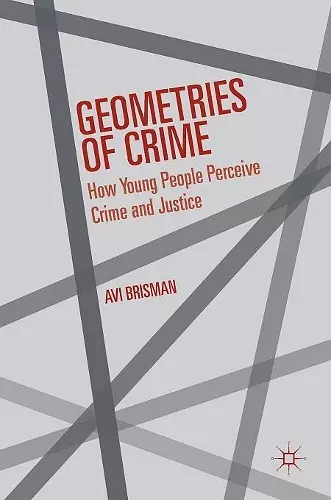Geometries of Crime
How Young People Perceive Crime and Justice
Format:Hardback
Publisher:Palgrave Macmillan
Published:11th Aug '16
Should be back in stock very soon

"This book is about how we define crime. Anthropologist and criminologist Avi Brisman examines the theoretical analyses of criminologists who abstractly define crime in its multiple dimensions. He juxtaposes these geometries of crime against the common sense everyday understanding he derived from an ethnography of Brooklyn teens. In doing so Brisman challenges the chefs of criminology to respect the ingredients of the Street and to transcend the adult-limited perceptions on which such analyses are based. The result is a rich feast of subtleties and nuances that nurture the criminological imagination and add missing flavors to our thinking about what constitutes crime." (Stuart Henry, Director of the School of Public Affairs, San Diego State University and co-editor of What is Crime?) "This perceptive ethnography offers a rare look into the inner workings of a diversionary Youth Court program, providing important insights into how young participants make sense of notions of law and order and how the court operates to construct definitions of criminality, delinquency and meaningful justice. Throughout the book, Brisman raises salient and much needed questions about the complicated role of community courts and therapeutic jurisprudence, more generally." (Carla J. Barrett, Assistant Professor, Sociology, John Jay College of Criminal Justice) "Justice is in the eye of the beholder and criminal justice likewise depends upon the angle from which we view it. How people think and feel about criminal justice, including criminologists, is forged within particular social, cultural and institutional settings and contexts. This fascinating book asks us to open our ears to the voices of young people caught up in the juvenile justice system. If and when we do so, the architecture of the system will never be seen the same again. A must read." (Rob White, Professor of Criminology, University of Tasmania, Australia)
This book explores how young people perceive the severity of crime and delinquency. In so doing, it offers thick description of young peoples' conceptions of and experiences with crime, delinquency, justice and law, and uses this description to interrogate the role of the state in influencing - indeed, shaping - these perceptions.This book explores how young people perceive the severity of crime and delinquency. It particularly addresses whom or what they consider to be the victims of crime and delinquency, how they analyze and assess appropriate responses by the criminal justice system, as well as their place within it. The book proposes tools for developing a more elaborate and robust understanding of what constitutes crime, identifying those affected by it, and what is deemed adequate or appropriate punishment. In so doing, it offers thick description of young peoples' conceptions of and experiences with crime, delinquency, justice and law, and uses this description to interrogate the role of the state in influencing - indeed, shaping - these perceptions.
“Brisman’s work—like his title—is a complex and layered geometry of claims that in fact emerge out of his deeply reflective concerns with the very project he initiated. His work is to be read carefully, as it is in fact a very layered story of one scholar’s own process of grappling with what at first attracted him as an innovation that was a step forward in terms of dismantling traditional criminal justice structures … .” (Alexandra Cox, Critical Criminology, Vol. 25 (1), March, 2017)
“Avi Brisman’s Geometries of Crime: How Young People Perceive Crime challenges the theoretical analyses of criminologists who define crime using geometric models. … One of the strengths of this book is Brisman’s focus on the criminal justice system as perceived by RHCJC youth. … Geometries of Crime provides critical insight for academics and criminal justice practitioners considering the relevance of youths’ perceptions within the criminal justice system.” (James Gacek, The Annual Review of Interdisciplinary Justice Research, Vol. 6, 2017)ISBN: 9781137546197
Dimensions: unknown
Weight: unknown
249 pages
1st ed. 2016